

Let's consider case when at expiration time stock price is out of the range of break-even points and let's say it rises to $56. Then Call options you wrote are in-the-money and you have to sell them for strike $40. But you own just one stock and you have to buy another one in the market (-$56). After you deliver these stocks (2*40) your loss is
These cases in Investor are shown below

As you see you can design your investment in a way that will make the return to fall in a certain adjustable range, or in other words, make the investment return predictable.
Opposite to Option Hedge strategy is called Reverse Option Hedge. The purpose of using this investment position is to get positive return when underlying asset price moves away from the strike price, or in other words, when price is outside the range that is between break-even points. Within range of break-even points, or close to strike price, you lose money. Let's consider example when you borrow XYZ stock (take a short position in XYZ stock) priced at $42 and sell it in the market. You also buy two Call options (Long Call) on XYZ stock for $2 each with strike $42. If at expiration time the stock price is outside the region between break-even points $38 and $46, and let's say equals to $47, you exercise two Call options (-2*42), return back one stock you owe and after selling another stock in the market ($47) your profit is
If stock price is within range between two break-even points and let's say equals to $44 then your loss is
These cases in Investor are shown below

Besides Option Hedge and Reverse Option hedge there are other derivative
trading strategies that can be used to design investments with certain
predictable outcomes. Spreads and Combinations involve several options and
allow to design required profit patterns. In Investor you can find them
under Trade tab.
